 | | | Switch to: Europe, USA, New Zealand, Antarctica Credit: NOAA/Ovation  Planetary K-index Planetary K-index
Now: Kp= 0.67 quiet
24-hr max: Kp= 2.67 quiet
explanation | more data
Interplanetary Mag. Field
Btotal: 7.75 nT
Bz: 4.79 nT north
more data: ACE, DSCOVR
Updated: Today at 1147 UT  Coronal Holes: 28 Apr 25 Coronal Holes: 28 Apr 25 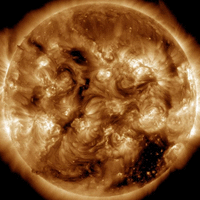
There are no large equatorial coronal holes on the Earthside of the sun. Credit: NASA/SDO | more data  Polar Stratospheric Clouds
Colorful Type II polar stratospheric clouds (PSC) form when the temperature in the stratosphere drops to a staggeringly low -85C. NASA's MERRA-2 climate model predicts when the air up there is cold enough: 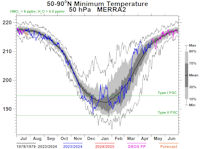
On April 28, 2025, the Arctic stratosphere is much too hot for Type II clouds. | more data. Noctilucent Clouds
The southern season for noctilucent clouds (NLCs) is finished. The first clouds were detected over Antarctica on Nov. 19, 2024, and they vanished again on Feb. 21, 2025. The action will shift to the north pole in late May 2025. Until then, the map will remain blank.
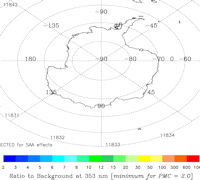
Updated: Feb. 21, 2025
An instrument onboard NOAA 21 (OMPS LP) is able to detect NLCs (also known as "polar mesospheric clouds" or PMCs). In the daily map, above, each dot is a detected cloud. As the season progresses, these dots will multiply in number and shift in hue from blue to red as the brightness of the clouds intensifies.
 SPACE WEATHER
NOAA Forecasts | | Updated at: 2025 Apr 28 2200 UTC FLARE | 0-24 hr | 24-48 hr | CLASS M | 15 % | 15 % | CLASS X | 01 % | 01 % |  Geomagnetic Storms: Geomagnetic Storms:
Probabilities for significant disturbances in Earth's magnetic field are given for three activity levels: active, minor storm, severe storm Updated at: 2025 Apr 28 2200 UTC Mid-latitudes | 0-24 hr | 24-48 hr | ACTIVE | 20 % | 10 % | MINOR | 05 % | 01 % | SEVERE | 01 % | 01 % | High latitudes | 0-24 hr | 24-48 hr | ACTIVE | 15 % | 15 % | MINOR | 25 % | 20 % | SEVERE | 30 % | 20 % | | | |  | | | | | | | | | | | This is an AI Free Zone: Text created by Large Language Models is spreading across the Internet. It's well-written, but frequently inaccurate. If you find a mistake on Spaceweather.com, rest assured it was made by a real human being. | | | BIG SUNSPOT ALERT: A big new sunspot is emerging over the sun's northeastern limb, right here. The topology of its magnetic field is not yet visible, so we cannot assess its potential for solar flares. However, big sunspots often produce big flares, so stay tuned. Solar flare alerts: SMS Text A SOLAR ECLIPSE IN SPACE: Yesterday, the Moon eclipsed the sun. No one on Earth saw it. The "lunar transit" was only visible from space. NASA's Solar Dynamics Observatory (SDO) recorded the whole thing from geosynchronous orbit: 
At maximum, 23% of the sun was covered. That makes it a partial eclipse. Every year, SDO observes multiple lunar transits. An eclipse on July 25th will be much deeper: 62%. SDO is solar powered, but it won't "brown out" in May because mission contollers will give the spacecraft's batteries an extra charge before the eclipse. Bonus: You can see lunar mountains in these images. Zoom in to the edge of the Moon: 
This high-res photo is valuable to the SDO science team. Undulations in the sharp edge of the Moon help researchers measure how light diffracts around the telescope's optics and filter support grids. Once these are calibrated, it is possible to correct SDO data for instrumental effects and sharpen the images even more than before. Realtime Space Weather Photo Gallery
Free: Spaceweather.com Newsletter
TOMATO SEEDS FROM SPACE: Spring has arrived, which means it's time to plant your space garden. These tomato seeds have flown to the edge of space onboard an Earth to Sky Calculus cosmic ray research balloon:
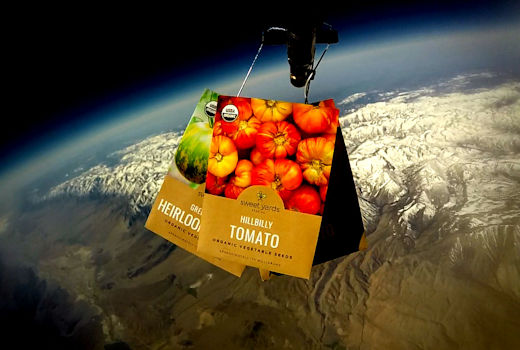
By popular demand, we flew a new batch of tomato seeds on April 20, 2025.
You can have a full packet for $49.95. Space seeds make a great DIY science project. During the flight, they spent more than 3 hours floating through the stratosphere, exposed to temperatures as low as -62 C and cosmic ray fluxes 100x Earth-normal. Each space-flown packet comes with an identical control packet, which remained on Earth during the flight. Plant them side by side to discover the difference space travel makes. Far Out Gifts: Earth to Sky Store
All sales support hands-on STEM education
Realtime Aurora Photo Gallery
Free: Spaceweather.com Newsletter
Realtime Comet Photo Gallery
Free: Spaceweather.com Newsletter Every night, a network of NASA all-sky cameras scans the skies above the United States for meteoritic fireballs. Automated software maintained by NASA's Meteoroid Environment Office calculates their orbits, velocity, penetration depth in Earth's atmosphere and many other characteristics. Daily results are presented here on Spaceweather.com. On Apr 27, 2025, the network reported 4 fireballs.
(2 eta Aquarids, 2 sporadics) 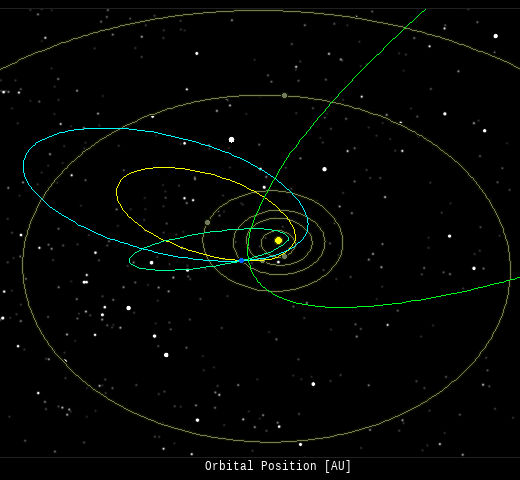 In this diagram of the inner solar system, all of the fireball orbits intersect at a single point--Earth. The orbits are color-coded by velocity, from slow (red) to fast (blue). [Larger image] [movies] Potentially Hazardous Asteroids ( PHAs) are space rocks larger than approximately 100m that can come closer to Earth than 0.05 AU. None of the known PHAs is on a collision course with our planet, although astronomers are finding new ones all the time. On April 28, 2025 there were 2349 potentially hazardous asteroids.
 | Recent & Upcoming Earth-asteroid encounters: | Asteroid | Date(UT) | Miss Distance | Velocity (km/s) | Diameter (m) | | 2025 HO4 | 2025-Apr-23 | 12 LD | 19.9 | 41 | | 2025 HF | 2025-Apr-23 | 2.3 LD | 9.1 | 27 | | 2025 HN | 2025-Apr-23 | 5.2 LD | 11.5 | 15 | | 2025 HH1 | 2025-Apr-23 | 13.8 LD | 17.9 | 32 | | 2025 HX3 | 2025-Apr-23 | 3 LD | 10.2 | 12 | | 2025 HM | 2025-Apr-24 | 15.1 LD | 11.6 | 103 | | 2025 HF1 | 2025-Apr-24 | 1 LD | 14.7 | 19 | | 2019 FY2 | 2025-Apr-24 | 12.8 LD | 5.3 | 12 | | 2025 HX | 2025-Apr-24 | 3.5 LD | 12.6 | 11 | | 2025 HT | 2025-Apr-25 | 3.3 LD | 6.8 | 18 | | 2025 HR4 | 2025-Apr-25 | 2.7 LD | 6.5 | 11 | | 462959 | 2025-Apr-25 | 12.9 LD | 9.5 | 217 | | 2025 HU2 | 2025-Apr-25 | 1.1 LD | 7.1 | 6 | | 2025 FK28 | 2025-Apr-25 | 16.6 LD | 11.9 | 63 | | 2025 HP1 | 2025-Apr-26 | 9.2 LD | 8.5 | 15 | | 2025 HV | 2025-Apr-27 | 14.6 LD | 16.5 | 48 | | 2025 HO2 | 2025-Apr-27 | 7 LD | 7.9 | 56 | | 2025 HS1 | 2025-Apr-27 | 14.5 LD | 11.3 | 30 | | 2025 HY | 2025-Apr-27 | 10.7 LD | 10.7 | 18 | | 2025 HP4 | 2025-Apr-28 | 0.9 LD | 10.1 | 10 | | 2025 HL3 | 2025-Apr-28 | 14 LD | 7.6 | 45 | | 2025 HQ4 | 2025-Apr-28 | 4.8 LD | 13.4 | 23 | | 2025 HN4 | 2025-Apr-28 | 1.7 LD | 8 | 13 | | 2025 HG2 | 2025-Apr-28 | 6.4 LD | 4.9 | 11 | | 2025 HW1 | 2025-Apr-28 | 3.2 LD | 19.7 | 25 | | 2025 HL5 | 2025-Apr-29 | 1.6 LD | 8.4 | 26 | | 2025 HM4 | 2025-Apr-30 | 2 LD | 18.9 | 20 | | 2025 GT1 | 2025-May-01 | 11.3 LD | 11.1 | 36 | | 2024 BF | 2025-May-01 | 9.5 LD | 4.6 | 46 | | 2025 HJ5 | 2025-May-02 | 10.9 LD | 7.8 | 15 | | 2025 HR1 | 2025-May-02 | 12.5 LD | 6.3 | 13 | | 2024 JM2 | 2025-May-03 | 7.2 LD | 11.3 | 62 | | 2025 HN3 | 2025-May-04 | 7.9 LD | 14 | 29 | | 2025 HF5 | 2025-May-06 | 3.6 LD | 4.3 | 25 | | 2021 JN1 | 2025-May-06 | 18.3 LD | 16.3 | 39 | | 2025 HY2 | 2025-May-07 | 17.8 LD | 13.6 | 38 | | 2021 HZ | 2025-May-08 | 20 LD | 10.2 | 30 | | 612356 | 2025-May-09 | 11 LD | 5.1 | 305 | | 2021 KH | 2025-May-10 | 18.3 LD | 7.2 | 19 | | 2011 HJ7 | 2025-May-12 | 6.6 LD | 15.8 | 118 | | 2011 YU74 | 2025-May-13 | 11.4 LD | 5 | 90 | | 2025 DT50 | 2025-May-14 | 16 LD | 6.4 | 105 | | 2008 ST | 2025-May-20 | 13.5 LD | 2.5 | 14 | | 387746 | 2025-May-24 | 17.4 LD | 8.3 | 339 | | 2014 KF22 | 2025-May-25 | 9.1 LD | 11.5 | 19 | | 390725 | 2025-May-25 | 18.4 LD | 13.5 | 410 | | 2025 FU5 | 2025-May-28 | 13.4 LD | 7.3 | 92 | | 2022 KP3 | 2025-May-30 | 10.2 LD | 7.7 | 7 | | 424482 | 2025-Jun-05 | 9.1 LD | 6.2 | 421 | | 2020 LQ | 2025-Jun-06 | 17.3 LD | 11.8 | 34 | | 2018 LE4 | 2025-Jun-07 | 12.2 LD | 13.3 | 62 | | 2014 LL26 | 2025-Jun-08 | 8 LD | 5.2 | 31 | | 2022 KQ5 | 2025-Jun-12 | 13.6 LD | 5.1 | 5 | | 2023 XO15 | 2025-Jun-15 | 17.8 LD | 3.4 | 24 | | 2000 LF3 | 2025-Jun-17 | 18.9 LD | 14.5 | 169 | | 2023 XU2 | 2025-Jun-18 | 11.1 LD | 15.6 | 32 | | 2003 AY2 | 2025-Jun-22 | 14.2 LD | 15.9 | 386 | Notes: LD means "Lunar Distance." 1 LD = 384,401 km, the distance between Earth and the Moon. 1 LD also equals 0.00256 AU. | | Cosmic Rays in the Atmosphere | SPACE WEATHER BALLOON DATA: Almost once a week, Spaceweather.com and the students of Earth to Sky Calculus fly space weather balloons to the stratosphere over California. These balloons are equipped with sensors that detect secondary cosmic rays, a form of radiation from space that can penetrate all the way down to Earth's surface. Our monitoring program has been underway without interruption for 10 years, resulting in a unique dataset of in situ atmospheric measurements. Latest results (Nov. 2024): Atmospheric radiation is decreasing in 2024. Our latest measurements in November registered a 10-year low: 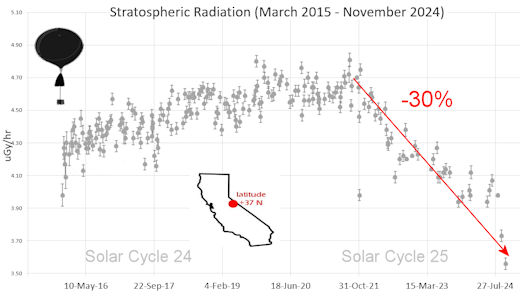
What's going on? Ironically, the radiation drop is caused by increasing solar activity. Solar Cycle 25 has roared to life faster than forecasters expected. The sun's strengthening and increasingly tangled magnetic field repels cosmic rays from deep space. In addition, solar coronal mass ejections (CMEs) sweep aside cosmic rays, causing sharp reductions called "Forbush Decreases." The two effects blend together to bring daily radiation levels down. .Who cares? Cosmic rays are a surprisingly "down to Earth" form of space weather. They can alter the chemistry of the atmosphere, trigger lightning, and penetrate commercial airplanes. According to a study from the Harvard T.H. Chan school of public health, crews of aircraft have higher rates of cancer than the general population. The researchers listed cosmic rays, irregular sleep habits, and chemical contaminants as leading risk factors. A number of controversial studies (#1, #2, #3, #4) go even further, linking cosmic rays with cardiac arrhythmias and sudden cardiac death. Technical notes: The radiation sensors onboard our helium balloons detect X-rays and gamma-rays in the energy range 10 keV to 20 MeV. These energies span the range of medical X-ray machines and airport security scanners. Data points in the graph labeled "Stratospheric Radiation" correspond to the peak of the Regener-Pfotzer maximum, which lies about 67,000 feet above central California. When cosmic rays crash into Earth's atmosphere, they produce a spray of secondary particles that is most intense at the entrance to the stratosphere. Physicists Eric Regener and Georg Pfotzer discovered the maximum using balloons in the 1930s and it is what we are measuring today. | | The official U.S. government space weather bureau | | | The first place to look for information about sundogs, pillars, rainbows and related phenomena. | | | Researchers call it a "Hubble for the sun." SDO is the most advanced solar observatory ever. | | | 3D views of the sun from NASA's Solar and Terrestrial Relations Observatory | | | Realtime and archival images of the Sun from SOHO. | | | information about sunspots based on the latest NOAA/USAF Active Region Summary | | | current counts of failed and deployed Starlink satellites from Jonathan's Space Page. See also, all satellite statistics. | | | Authoritative predictions of space junk and satellite re-entries | | | from the NOAA Space Environment Center | | | fun to read, but should be taken with a grain of salt! Forecasts looking ahead more than a few days are often wrong. | | | from the NOAA Space Environment Center | | | the underlying science of space weather |  | Got a chipped or cracked windshield that prevents you from seeing space weather events while driving? Get windshield replacement from SR Windows & Glass with free mobile auto glass service anywhere in the Phoenix area. |  | BestCSGOGambling is the best site for everything related to CSGO gambling on the web | | | These links help Spaceweather.com stay online. Thank you to our supporters! | | | | | | | | |  | |  |   | ©2021 Spaceweather.com. All rights reserved. This site is penned daily by Dr. Tony Phillips. | |

